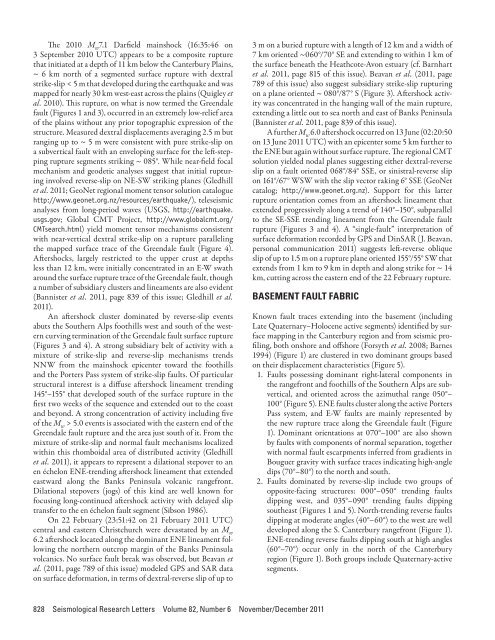Here - Stuff
Here - Stuff
Here - Stuff
You also want an ePaper? Increase the reach of your titles
YUMPU automatically turns print PDFs into web optimized ePapers that Google loves.
The 2010 M w 7.1 Darfield mainshock (16:35:46 on3 September 2010 UTC) appears to be a composite rupturethat initiated at a depth of 11 km below the Canterbury Plains,~ 6 km north of a segmented surface rupture with dextralstrike-slip < 5 m that developed during the earthquake and wasmapped for nearly 30 km west-east across the plains (Quigley etal. 2010). This rupture, on what is now termed the Greendalefault (Figures 1 and 3), occurred in an extremely low-relief areaof the plains without any prior topographic expression of thestructure. Measured dextral displacements averaging 2.5 m butranging up to ~ 5 m were consistent with pure strike-slip ona subvertical fault with an enveloping surface for the left-steppingrupture segments striking ~ 085°. While near-field focalmechanism and geodetic analyses suggest that initial rupturinginvolved reverse-slip on NE-SW striking planes (Gledhillet al. 2011; GeoNet regional moment tensor solution cataloguehttp://www.geonet.org.nz/resources/earthquake/), teleseismicanalyses from long-period waves (USGS, http://earthquake.usgs.gov; Global CMT Project, http://www.globalcmt.org/CMTsearch.html) yield moment tensor mechanisms consistentwith near-vertical dextral strike-slip on a rupture parallelingthe mapped surface trace of the Greendale fault (Figure 4).Aftershocks, largely restricted to the upper crust at depthsless than 12 km, were initially concentrated in an E-W swatharound the surface rupture trace of the Greendale fault, thougha number of subsidiary clusters and lineaments are also evident(Bannister et al. 2011, page 839 of this issue; Gledhill et al.2011).An aftershock cluster dominated by reverse-slip eventsabuts the Southern Alps foothills west and south of the westerncurving termination of the Greendale fault surface rupture(Figures 3 and 4). A strong subsidiary belt of activity with amixture of strike-slip and reverse-slip mechanisms trendsNNW from the mainshock epicenter toward the foothillsand the Porters Pass system of strike-slip faults. Of particularstructural interest is a diffuse aftershock lineament trending145°–155° that developed south of the surface rupture in thefirst two weeks of the sequence and extended out to the coastand beyond. A strong concentration of activity including fiveof the M w > 5.0 events is associated with the eastern end of theGreendale fault rupture and the area just south of it. From themixture of strike-slip and normal fault mechanisms localizedwithin this rhomboidal area of distributed activity (Gledhillet al. 2011), it appears to represent a dilational stepover to anen échelon ENE-trending aftershock lineament that extendedeastward along the Banks Peninsula volcanic rangefront.Dilational stepovers (jogs) of this kind are well known forfocusing long-continued aftershock activity with delayed sliptransfer to the en échelon fault segment (Sibson 1986).On 22 February (23:51:42 on 21 February 2011 UTC)central and eastern Christchurch were devastated by an M w6.2 aftershock located along the dominant ENE lineament followingthe northern outcrop margin of the Banks Peninsulavolcanics. No surface fault break was observed, but Beavan etal. (2011, page 789 of this issue) modeled GPS and SAR dataon surface deformation, in terms of dextral-reverse slip of up to3 m on a buried rupture with a length of 12 km and a width of7 km oriented ~060°/70° SE and extending to within 1 km ofthe surface beneath the Heathcote-Avon estuary (cf. Barnhartet al. 2011, page 815 of this issue). Beavan et al. (2011, page789 of this issue) also suggest subsidiary strike-slip rupturingon a plane oriented ~ 080°/87° S (Figure 3). Aftershock activitywas concentrated in the hanging wall of the main rupture,extending a little out to sea north and east of Banks Peninsula(Bannister et al. 2011, page 839 of this issue).A further M w 6.0 aftershock occurred on 13 June (02:20:50on 13 June 2011 UTC) with an epicenter some 5 km further tothe ENE but again without surface rupture. The regional CMTsolution yielded nodal planes suggesting either dextral-reverseslip on a fault oriented 068°/84° SSE, or sinistral-reverse slipon 161°/67° WSW with the slip vector raking 6° SSE (GeoNetcatalog; http://www.geonet.org.nz). Support for this latterrupture orientation comes from an aftershock lineament thatextended progressively along a trend of 140°–150°, subparallelto the SE-SSE trending lineament from the Greendale faultrupture (Figures 3 and 4). A “single-fault” interpretation ofsurface deformation recorded by GPS and DinSAR (J. Beavan,personal communication 2011) suggests left-reverse obliqueslip of up to 1.5 m on a rupture plane oriented 155°/55° SW thatextends from 1 km to 9 km in depth and along strike for ~ 14km, cutting across the eastern end of the 22 February rupture.BASEMENT FAULT FABRICKnown fault traces extending into the basement (includingLate Quaternary–Holocene active segments) identified by surfacemapping in the Canterbury region and from seismic profiling,both onshore and offshore (Forsyth et al. 2008; Barnes1994) (Figure 1) are clustered in two dominant groups basedon their displacement characteristics (Figure 5).1. Faults possessing dominant right-lateral components inthe rangefront and foothills of the Southern Alps are subvertical,and oriented across the azimuthal range 050°–100° (Figure 5). ENE faults cluster along the active PortersPass system, and E-W faults are mainly represented bythe new rupture trace along the Greendale fault (Figure1). Dominant orientations at 070°–100° are also shownby faults with components of normal separation, togetherwith normal fault escarpments inferred from gradients inBouguer gravity with surface traces indicating high-angledips (70°–80°) to the north and south.2. Faults dominated by reverse-slip include two groups ofopposite-facing structures: 000°–050° trending faultsdipping west, and 035°–090° trending faults dippingsoutheast (Figures 1 and 5). North-trending reverse faultsdipping at moderate angles (40°–60°) to the west are welldeveloped along the S. Canterbury rangefront (Figure 1).ENE-trending reverse faults dipping south at high angles(60°–70°) occur only in the north of the Canterburyregion (Figure 1). Both groups include Quaternary-activesegments.828 Seismological Research Letters Volume 82, Number 6 November/December 2011
















